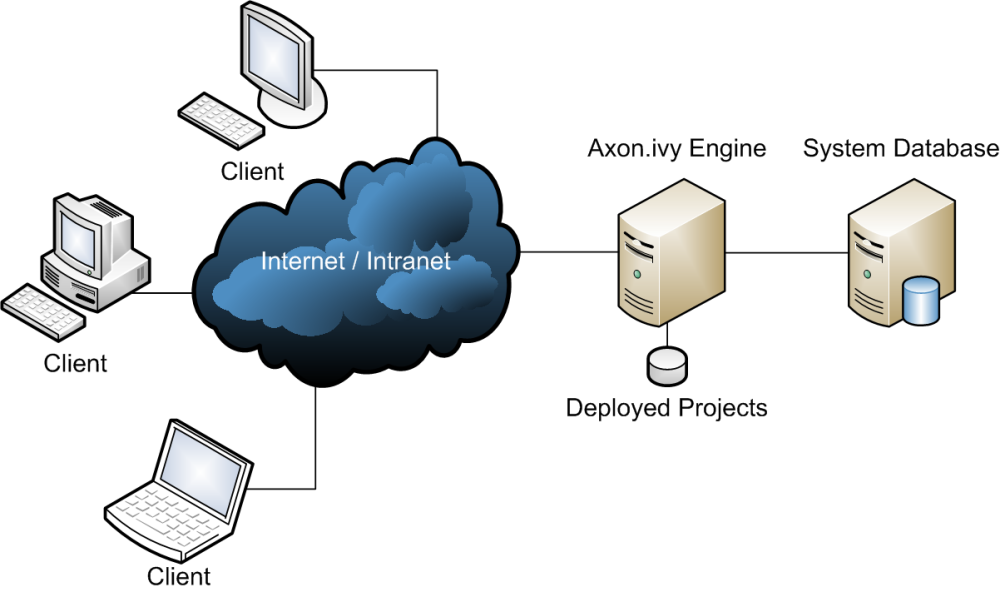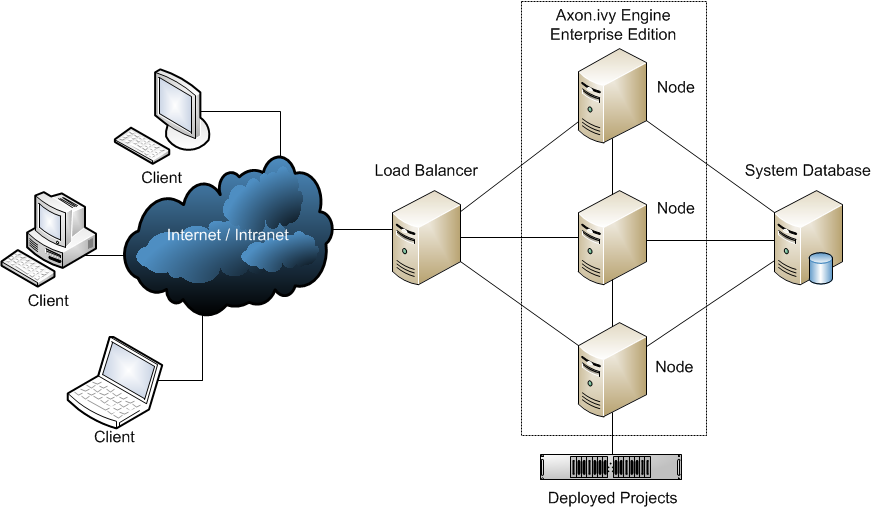Introduction
About this guide
You are now reading Axon.ivy Engine documentation. In case you want to know more on:
Download the latest Axon.ivy version.
Read the Readme.html in the installation directory for the system requirements.
Start with the Getting Started chapter to quickly run an Axon.ivy Engine.
Explore demo projects in the Axon.ivy Designer and deploy them to the Axon.ivy Engine.
Read the designer guide to know how to model, simulate and implement digital business process.
Go trough the Migration Notes to upgrade an existing Axon.ivy Engine.
All above mentioned documentations are brief and tend to describe only necessary functionality. We highly encourage reading these documentations to speed up your development, to get to know new features or to eliminate potential problems.
Installation Environment
The following diagram shows the installation environment of an Axon.ivy Engine:

Axon.ivy Engine Installation
The Axon.ivy Engine needs a system database to store its configuration, users, roles and assigned permissions and the states, cases, tasks from the deployed applications. Next, it needs file directories where the deployed projects are stored. The Axon.ivy Engine integrates a Tomcat servlet engine that is responsible to receive HTTP or HTTPS requests from client applications and to send back appropriate responses (similar to a web server). The client applications are Web Applications that run in a web browser, which communicate over HTTP or HTTPS directly with the servlet engine. In a productive environment, normally a Microsoft Internet Information Server (IIS), Apache Web Server, NGINX reverse proxy or a web application firewall (WAF) often combined with an identity and access management (IAM) system is put in front of the Axon.ivy Engine The front-end servers are then responsible to forward the requests to the Axon.ivy Engine Servlet Container. Also, the users are imported from an external security system like a Microsoft Active Directory or Novell eDirectory. Axon.ivy applications can integrate with third party external systems like databases, web services or application servers. Axon.ivy Engine also integrates an Elasticsearch server. Instead using the integrated Elasticsearch server also an external Elasticsearch server can be used.
Engine Edition
We distinguish between the Standard Edition and the Enterprise Edition.
Standard Edition
The Axon.ivy Engine Standard Edition is installed on a single machine. A DBMS that can hold the Axon.ivy system database is the only special infrastructure it needs. The deployed projects can be stored on a local harddisk on same machine that the Axon.ivy Engine Standard Edition is running on.

Axon.ivy Engine Standard Edition
Enterprise Edition
The Axon.ivy Engine Enterprise Edition is a cluster of multiple Axon.ivy Engine instances. It is built on a load balancer that receives requests from the clients and forwards them to multiple Axon.ivy Engine nodes typically running on different machines. The different nodes of an Axon.ivy Engine Enterprise Edition all share the same system database which is normally stored on a dedicated database. The deployed projects are stored on a file system that can be accessed by all nodes.

Axon.ivy Engine Enterprise Edition
Axon.ivy Engine Nodes are typically installed on multiple server machines, but it is also possible to install more than one Axon.ivy Engine Node on a single server machine. The load balancer can be realized either by a hardware load balancer or by an IIS or Apache web server that distributes the incoming requests to the installed Axon.ivy Engine Nodes.
What engine edition do I need?
The Enterprise Edition has two major advantages compared to the Standard Edition:
Performance and scalability: An Axon.ivy Engine Enterprise Edition can serve more clients than the Axon.ivy Engine Standard Edition. If your number of clients increases, you can add another Engine node to your Axon.ivy Engine cluster. If you have a lot of sessions it may even be better to have two Axon.ivy Engine nodes on the same server machine instead of having a single Standard Edition. Because each session needs memory on the engine and Axon.ivy can handle two processes with medium memory footprints (i.e. Engine nodes) faster than one process with a large memory footprint (i.e. Standard Edition).
High availability: In an Axon.ivy Engine Enterprise Edition installation, a single node may crash without affecting the other nodes, which still serve clients. However, if you require high availability of your Axon.ivy Engine you also need to ensure that all other components the engine is depending on (Load Balancer, Database Server, File Share) have a high availability.
There are some disadvantages of the Enterprise Edition compared to the Standard Edition like more complexity of the system, higher hardware costs and higher licence fees.